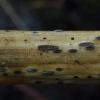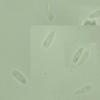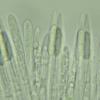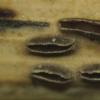
02-07-2025 09:32
 Nicolas VAN VOOREN
Nicolas VAN VOOREN
Hello, bonjour.Here is the paper I'm searching for

30-06-2025 16:56
Lydia KoelmansPlease can anyone tell me the species name of the

01-07-2025 23:37
Hello.A Pleosporal symbiotic organism located and

30-06-2025 12:09
 Edvin Johannesen
Edvin Johannesen
This tiny, rather "rough" erumpent asco was found

30-06-2025 06:57
Ethan CrensonHi all, Another find by a friend yesterday in Bro

30-06-2025 14:45
 Götz Palfner
Götz Palfner
This is a quite common species on Nothofagus wood

25-06-2025 16:56
Philippe PELLICIERBonjour, pensez-vous que S. ceijpii soit le nom co

29-06-2025 18:11
Ethan CrensonHello all, A friend found this disco yesterday in
Erumpent on Phragmites australis
Juuso Äikäs,
06-06-2020 20:25
Spore dimensions:
(6.5) 6.6 - 7.2 (7.3) × 2.1 - 2.4 (2.5) µm
Q = (2.8) 3 - 3.2 (3.3) ; N = 8
Me = 6.9 × 2.2 µm ; Qe = 3.1
Juuso Äikäs,
07-06-2020 13:54
Re : Erumpent on Phragmites australis
I managed to find one rather promising candidate: Hysterostegiella valvata.
http://www.centrodeestudiosmicologicosasturianos.org/?p=23617
In that source the substrate is apparently Ammophila arenaria, so Poaceae as well. Paraphyses look just right and spore size and appearance is also pretty much the same.
http://www.centrodeestudiosmicologicosasturianos.org/?p=23617
In that source the substrate is apparently Ammophila arenaria, so Poaceae as well. Paraphyses look just right and spore size and appearance is also pretty much the same.
Juuso Äikäs,
07-06-2020 15:32
Re : Erumpent on Phragmites australis
I have to clarify that in the first pic I think at least a part of those are actually Lophodermiums or something like that. I re-examined the sample and they had filiform spores. Both species are growing on the same culm near eachother. Here's a pic that I think is of the possible H. valvata:




